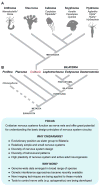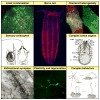Back to the Basics: Cnidarians Start to Fire
- PMID: 28041633
- PMCID: PMC5285349
- DOI: 10.1016/j.tins.2016.11.005
Back to the Basics: Cnidarians Start to Fire
Abstract
The nervous systems of cnidarians, pre-bilaterian animals that diverged close to the base of the metazoan radiation, are structurally simple and thus have great potential to reveal fundamental principles of neural circuits. Unfortunately, cnidarians have thus far been relatively intractable to electrophysiological and genetic techniques and consequently have been largely passed over by neurobiologists. However, recent advances in molecular and imaging methods are fueling a renaissance of interest in and research into cnidarians nervous systems. Here, we review current knowledge on the nervous systems of cnidarian species and propose that researchers should seize this opportunity and undertake the study of members of this phylum as strategic experimental systems with great basic and translational relevance for neuroscience.
Keywords: BRAIN Initiative; CRISPR; Hydra; Nematostella; imaging.
Copyright © 2016 Elsevier Ltd. All rights reserved.
Figures


References
-
- Cajal SR. In Nobel lectures, physiology or medicine 1901–1921. 1906.
-
- Shepherd GM. Foundations of the neuron doctrine. Oxford Univ Press; 1991.
-
- Yuste R. From the neuron doctrine to neural networks. Nat Rev Neurosci. 2015;16:487–497. - PubMed
-
- Kandel E, Schwartz J. Principles of Neural Science, Fifth Edition. McGraw-Hill Education; 2013.
Publication types
MeSH terms
Substances
Grants and funding
LinkOut - more resources
Full Text Sources
Other Literature Sources

